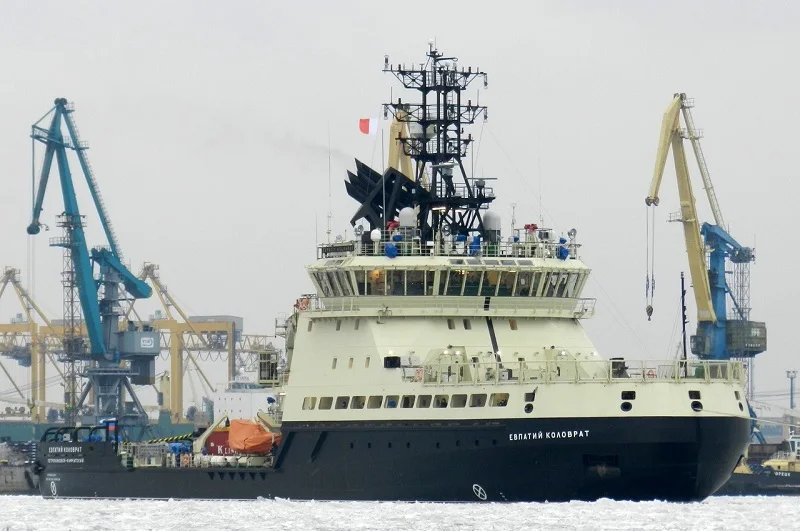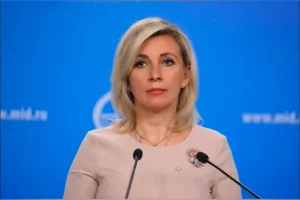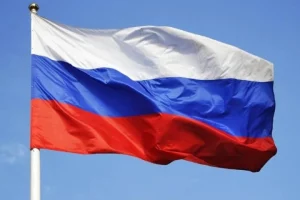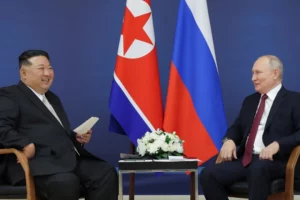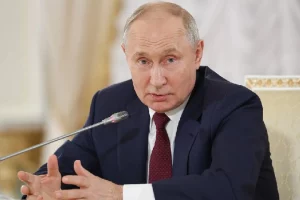Russia’s newest icebreaker ‘Evpatiy Kolovrat’, built for its Pacific Fleet, entered the Indian Ocean near Sri Lanka, earlier Thursday.
The icebreaker began an inter-fleet transition from Saint Petersburg to its future permanent base in the Kamchatka Peninsula in the Russian Far East in the last week of January.
The crossing route passes through the Mediterranean Sea and the Indian Ocean as the ship left the control of the Black Sea Fleet and came under the Territorial Control Centre of the Russian Pacific Fleet.
The vessel, laid down in 2018 at the Almaz shipbuilding company’s plant in Saint Petersburg, is expected to enter the Russian Navy later this year.
A number of innovative solutions have been introduced in the design and construction of the icebreaker. The ship’s displacement is just over 4000 tonnes and it is able to overcome ice up to 1.5 metre thick. It has a helipad in the bow and, if necessary, has provisions for anti-aircraft artillery installations. Having a crew of about 30 people, the icebreaker can reach speeds of up to 14 knots.
“The segment of the military shipbuilding programme, which includes equipping the Russian Navy with ships, icebreakers and support vessels, is one of the priorities, taking into account the active development of the Arctic zone by the Navy, ensuring the normal functioning of the Northern Sea Route, and hydrographic research in the Arctic,” said Admiral Nikolai Evmenov, the Commander-in-Chief of the Russian Navy in November 2020.
More significantly, by introducing new icebreakers and reinforced ice-class ships, Moscow is trying to ensure year-round navigation of its commercial fleet along the entire length of the Northern Sea Route to rapidly develop the Asia-Pacific market.
As reported by IndiaNarrative.com earlier, the utilization of the Northern Sea Route would strengthen the India-Russia partnership, especially when it comes to energy supplies.
Last month, as he addressed an India-Russia Business Dialogue along with visiting Russian Deputy Prime Minister and Minister of Trade and Industry Denis Manturov in New Delhi, External Affairs Minister S. Jaishankar spotlighted once again the development of transport corridors along the India-Russia route and container traffic between Indian and Russian Far Eastern ports.
The EAM spoke on the importance of connectivity initiatives, including the International North-South Transport Corridor (INSTC) as well as the Eastern Maritime Corridor (Chennai-Vladivostok Corridor) that India believes would play a key role in expanding and diversifying the bilateral trade and economic cooperation.
The commercial port of Vladivostok is the largest universal port in the Russian Far East. Its annual cargo turnover exceeds 12.9 million tons. Located on its territory, the Vladivostok railway station receives and dispatches up to 10 trains with the container and general cargo per day.
“The Eastern Maritime Corridor, I think, fits in with our goal, what is called ‘Act East Policy’, as well as the Russian policy of having the Far East come in as an additional driver of the economy. So, I think there is a synergy there which is waiting to be tapped,” said Jaishankar.
Upon arrival in Kamchatka, the icebreaker will be commissioned into the fleet of the Pacific Fleet and will continue to serve in the zone of responsibility of the troops and forces in the northeast of Russia.
Its tasks would not only include delivering cargo to remote garrisons but also piloting warships in icy conditions, transporting crews and hydrographic work.






